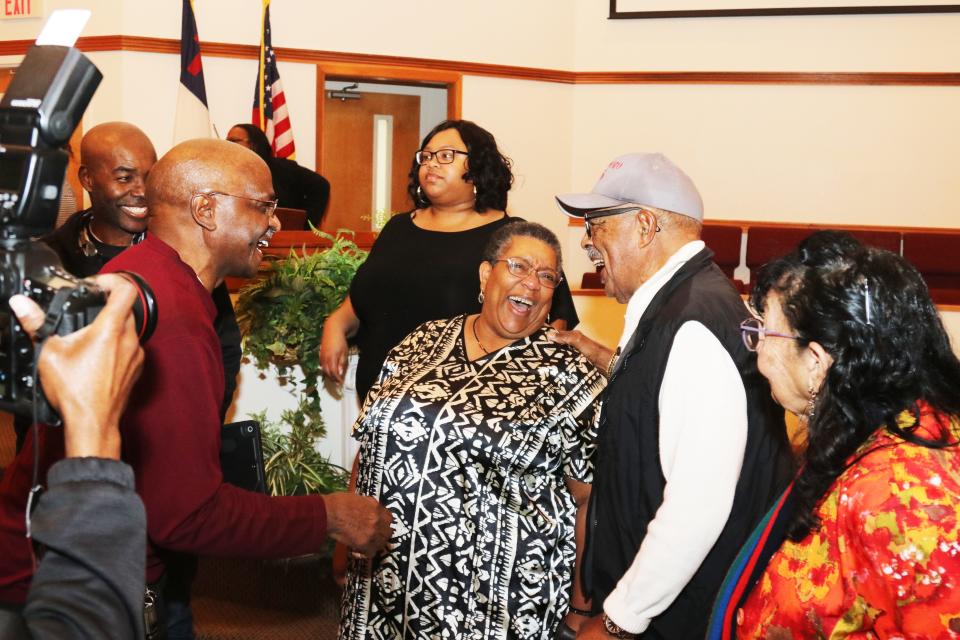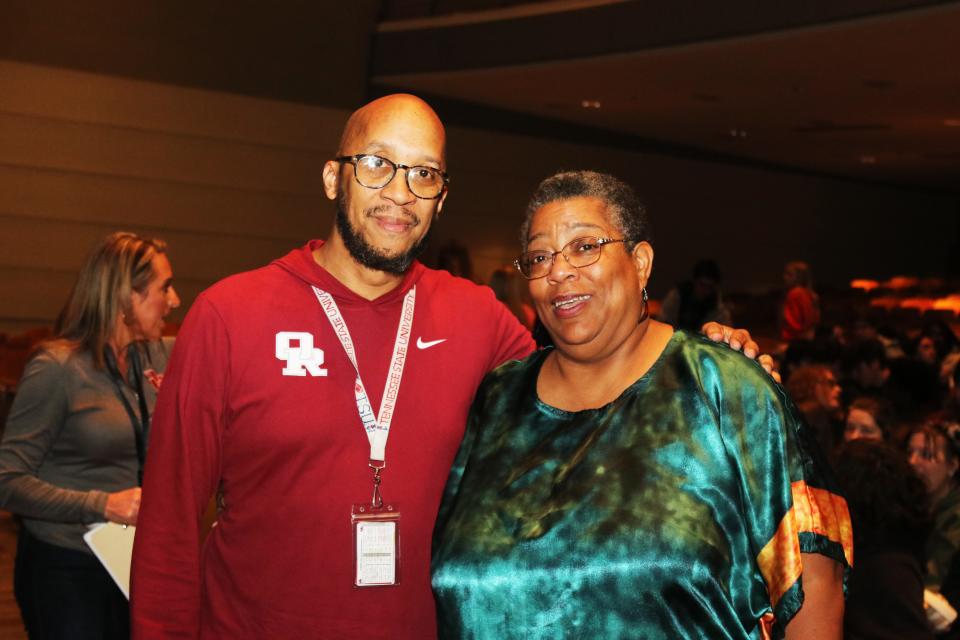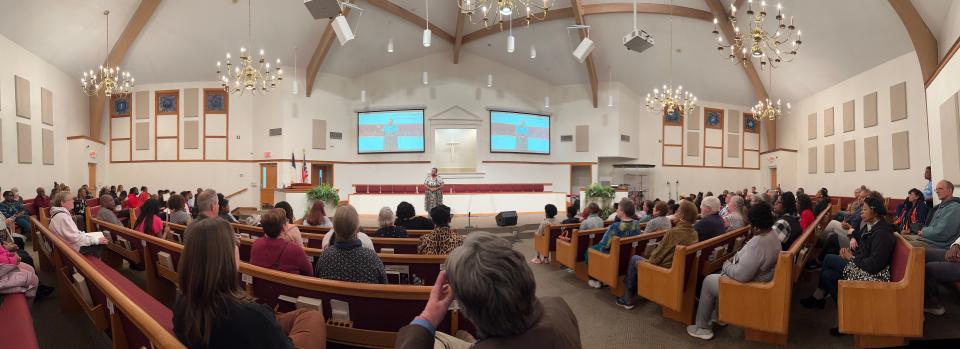Bringing Oak Ridge’s forgotten history alive
While many Americans learned the secret that Oak Ridge was responsible for making the nuclear fuel for the world's first atomic bomb, hardly anyone knew, over the decades since 1955, about a major civil rights victory in the city.
Oak Ridge was the site of the first desegregation of public schools in the Southeast. Those 85 brave students from the Scarboro School who desegregated two all-white Oak Ridge schools were the children of the Black workers from the Southeast who helped make World War II's Manhattan Project a success.

Sheila Arnold, the professional storyteller who gave numerous historical performances here last week, reminded audiences at public storytelling events that Scarboro has long been a “secret city” within the secret city of Oak Ridge. She presented remarkable insights into the lives of the Scarboro 85 – the 85 Black students who were forced by government edict to leave their beloved Scarboro School in September 1955 and desegregate Oak Ridge High School and Robertsville Junior High School.
She spoke to nine audiences, including people at Oak Valley Baptist Church in Scarboro, the American Museum of Science and Energy, and students at Robertsville - now a middle school - Jefferson Middle School and ORHS.

Arnold explained that military bases and cities controlled and funded by the Atomic Energy Commission (AEC) desegregated in 1955 some schools in response to the landmark 1954 U.S. Supreme Court ruling in the Brown vs. Board of Education case. The highest court decided that separating children in public schools because of race was unconstitutional, but nationwide desegregation of schools (including the other Oak Ridge schools) was not accomplished until the 1965-70 time period.
She said that thanks to the preparation of the Black students by Scarboro School Principal Arizona Officer and the successful administration of ORHS by Principal Tom Dunigan, “there was not violence.” But, she added, “there was harm done” to the Black students because they “were tolerated and not accepted” by the white students and some teachers and because “Oak Ridgers forgot the sacrifice they had made.”
At a meeting a few years ago, Arnold said, a man claimed that the 12 Black students who were the first to attend the all-white Clinton High School on Aug. 26, 1956, were responsible for the first desegregation of public schools in the Southeast. L.C. "Larry" Gipson of Oak Ridge stood up at the meeting and declared that the Scarboro 85 in Oak Ridge were the first.
“So, John Spratling, Rose Weaver and many other Black residents began interviewing those of the Scarboro 85 who were still alive, and I was brought in later to learn their stories,” Arnold said. She added that Spratling and Weaver are now trying to raise funds for a monument to “recognize the long, hard road of the Scarboro 85.” as they desegregated RJHS and ORHS.

In the meantime, the state of Tennessee has approved including the Scarboro 85 story in the required history curriculum of Tennessee schools, according to Ray Smith, city historian.
Growing up in Scarboro in the 1950s
So, what was it like to be a Black person or a white person in the 1950s in Oak Ridge?
Black adults lived mostly in Scarboro, then a thriving community hidden behind lots of trees.
“It had its own roller-skating rink, barber shops, beauty shops, auto shops and churches,” Arnold said, noting that the Black adults mostly “connected to white people” only if they had the higher paying jobs at AEC’s nuclear plants in Oak Ridge. The Scarboro residents, she added, “lived in two different worlds.”
There were those Scarboro residents who worked higher-paying jobs at the government plants, and students who who attended white schools - and those who didn't.
She noted that if Black families wanted to go to a restaurant in the 1950s - even after the two Oak Ridge schools were desegregated - the restaurant, like the rest of the town, abided by the Jim Crow laws of enforced segregation. In city buildings and restaurants, which Black people could enter only through the back door while white patrons came through the front door, there were “colored restrooms” and “white restrooms.” Oak Ridge movie theaters had “colored sections.” Before 1955 the pool was open only one day a week to Black people who wanted to swim.
Many white people living in Oak Ridge rarely saw a Black person in town in the 1950s, Arnold said.
Older Black children in Scarboro before September 1955 attended an L-shaped school that had many Black teachers with advanced degrees, Arnold said. The Scarboro School, which was started by Principal Officer and her husband, taught the older students on the short side of the “L” and the younger students on the longer side.
According to Arnold, Principal Officer and the teachers visited students’ homes, demanded excellence and respect, and encouraged the students to pursue a college education. They were also taught to protest nonviolently, “stay focused and not lose your cool,” said Arnold, who called Arizona Officer, after whom a wing in the new city-wide Oak Ridge Schools' Preschool in Scarboro is named, “tough, but she had a heart of gold.”
Arnold noted that when the 85 students left Scarboro School for the two all-white Oak Ridge schools, “they would lose all the teachers they knew except Fred Brown, the teacher brought over to Oak Ridge High School from the Scarboro School and the only Black teacher on the high school faculty.”
Brown, who taught shop and history at ORHS, eventually became a professor at the University of Tennessee at Knoxville, where a building is named for him.
She then told the story of an unnamed 14-year-old boy from Scarboro who woke up afraid on the morning of Sept. 6, 1955. Instead of walking to the Scarboro School he loved, he had to walk to the bus stop for his first trip to ORHS, where he would be a ninth grader. His father reminded him to make sure he had money in his pocket for the city bus.
The boy recalled all the days he and his best friend would joke and laugh as they bought candy from a local store before going to Scarboro School. On this day they both felt sad because the boy’s best friend had to go to an RJHS eighth-grade classroom.
At ORHS, the boy did what he was told: “keep your eyes down, walk near the wall so you won’t bump into anyone.” When he arrived in the classroom, the teacher told him to sit in the back where he realized the desks were better than those in Scarboro.
“He noticed that some teachers were kind and inclusive and others seemed to pretend that he didn’t exist,” Arnold said.
The boy felt scared and alone. He knew that 10 days earlier, the dead body of 14-year-old Emmett Till had been found floating on a river in Mississippi after he had been abducted, tortured and lynched. The reason: a white woman accused him falsely of whistling at her in her family’s grocery store.
“He had been beaten so severely that his face was unrecognizable, and one eye was completely gone,” Arnold said. The only way his mother could tell it was him was from a ring on his finger that was his father’s.
The Scarboro 85 had different experiences in the two desegregated Oak Ridge schools, Arnold said. Some were elected to the student council and the National Honor Society. Others joined the sports teams.
The tall, talented Black basketball players on the ORHS varsity team mostly “practiced basketball,” Arnold said. “They could not actually play with their teammates on the court if the other school said no. Sometimes they weren’t allowed to get on the bus to go to the other school to watch the game.” But on Dec. 3, 1955, one Black player became a pioneer for sports desegregation by playing a few minutes with the ORHS team against the all-white Powell Valley High School, which won by two points. This groundbreaking game received coverage in the New York Times.
During the 1955-56 school year at ORHS, Principal Tom Dunigan was “like the sheriff in town,” Arnold said. “He was absolutely convinced that it was right and good that the school was now desegregated. He told his daughter (Pat Dunigan Postma) that he was happy that he was there to enforce the desegregation effort.” He warned parents that protesting the desegregation might cost them their jobs.
Some Oak Ridgers were displeased with the mandated desegregation. The principal and his family received threatening phone calls. One day he saw a cross burning in his yard.
“He just cleaned it up,” Arnold remarked.
Some white students, like Pat Dunigan Postma, welcomed the Black students to ORHS. Others were not so kind.
“Principal Dunigan didn’t know about the young student who was thrown into a locker every day before a particular class,” Arnold said. “No one spoke up about it, including that young person.”
In June 1956, the first Black graduates of ORHS were invited to attend the first junior-senior integrated prom in a public school in the Southeast. Arnold noted that the community was still segregated, so it arranged for and paid for the prom afterparty for white students and gave money to the Black students to hold their own party. They did not do so; instead they donated the money to the School for the Blind.
How did the historical prom go? According to Arnold, “Two Black couples sat at a table with other white students. The white students stood up and walked away. No one talked to any of the Black couples. There were no fights. That’s when the Black students realized they had not been accepted; they had only been tolerated.”
Arnold said she would like to see a memorial to the Scarboro 85 placed by the International Friendship Bell in Bissell Park. “I am an ambassador,” she said as she called for Oak Ridgers to donate money through the www.scarboro85monument.com website to fund a memorial to help make “Oak Ridge a place of peace and reconciliation.”
She closed her story by saying, “Let us become a better people and do no harm.”
***
To contribute to a monument honoring the Scarboro 85, send your check to: Scarboro 85 Memorial Fund, c/o John Spratling, 201 Iroquois Rd., Oak Ridge, TN 37830.
The Oak Ridger's News Editor Donna Smith covers Oak Ridge area news. Email her at dsmith@oakridger.com and follow her on X, the social media platform formerly known as Twitter, @ridgernewsed.
Support The Oak Ridger by subscribing. Offers available at https://subscribe.

This article originally appeared on Oakridger: Bringing Oak Ridge’s forgotten history alive

